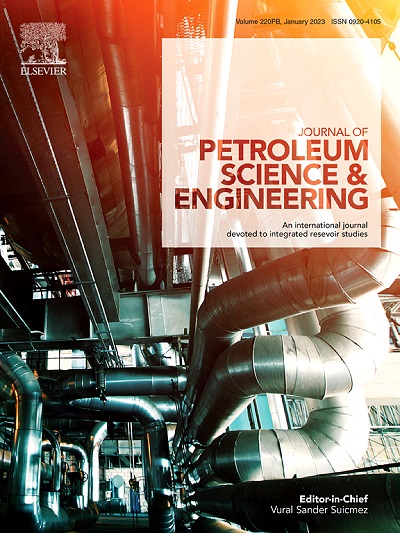Optimization of the Oxidative Desulphurization of Residual Oil Using Hydrogen Peroxide
2区 工程技术
Q1 Earth and Planetary Sciences
引用次数: 0
Abstract
: The role of fuel in global economy cannot be overemphasized, it is necessary to develop new and more efficient technologies in desulphurization processes at a low cost. This research focuses on optimization of desulphurization using oxidative method for higher yields, utilizing dual acetic/formic acid catalyst on residual oil with sulphur concentration > 0.50%wt and emphasizes the improvement of physicochemical properties primarily suitable for use in fuels where regulation is becoming more stringent. The process was conducted using H 2 O 2 oxidant concentration 12.5-25.0% (w/w), CH 3 COOH/HCOOH acid catalyst mixture 12.5-22.0% (w/w), and reaction temperature 40-60°C. Optimization of the desulphurization parameters was done using response surface methodology based on Box-Behnken design. The optimum yield of desulphurization (60.93%) was achieved at the oxidant 18.75% (w/w), acetic/formic mixture of 17.25% (w/w), and reaction temperature of 50°C. In general, the experimentally confirmatory figures in two solutions of 63.29 ± 0.47% and 61.04 ± 0.13% match the predicted values of 62.82% and 60.91%, respectively. The total sulphur content in residual oil was reduced from 0.67 to 0.26%wt. GC-MS of the untreated sample confirm the presence of 1,2-benzisothiazole,3-(hexahydro-1H-azepin-1-yl)- 1,1-dioxide, Nickel(II)bis(N,N-dihexyldithiocarbamate and Diethyl[3-[n-octadecylmercapto]-P-n-butyl-anilino methy lene] malonate with a total percentage peak area of 11.83%. In the treated sample shows no sulphur compounds. The physicochemical analysis for both treated and untreated residual oil according to ASTM were found to be within acceptable limit except sulphur content of untreated sample. After the desulphurization, treated residual oil shows a remarkable improvement in the physicochemical parameters. Hence can be applicable in industrial process and automobiles with very low sulphur emission.过氧化氢氧化脱硫渣油工艺的优化研究
燃料在全球经济中的作用怎么强调都不过分,有必要开发新的、更高效的低成本脱硫技术。本研究的重点是优化氧化法脱硫以提高收率,利用双乙酸/甲酸催化剂处理硫浓度为> 0.50%wt的渣油,并强调改善物化性能,主要适用于监管越来越严格的燃料。反应条件为h2o2氧化剂浓度12.5 ~ 25.0% (w/w), ch3cooh /HCOOH酸性催化剂浓度12.5 ~ 22.0% (w/w),反应温度40 ~ 60℃。采用基于Box-Behnken设计的响应面法对脱硫工艺参数进行了优化。当氧化剂用量为18.75% (w/w),乙酸/甲酸混合物用量为17.25% (w/w),反应温度为50℃时,脱硫收率为60.93%。总的来说,在63.29±0.47%和61.04±0.13%两种溶液下的实验验证值与预测值分别为62.82%和60.91%。残油中总硫含量由0.67 wt降至0.26%wt。未经处理的样品经GC-MS确认存在1,2-苯并异噻唑、3-(六氢- 1h -氮平-1-基)- 1,1-二氧化二氮、镍(II)二(N,N-二己基二硫代氨基甲酸乙酯和二乙基[3-[N-十八烷基巯基]- p -正丁基苯胺甲烯]丙二酸盐,总百分比峰面积为11.83%。经处理的样品中不含硫化合物。根据ASTM对处理过和未处理过的剩余油进行理化分析,除未处理样品的硫含量外,其余均在可接受范围内。经脱硫处理后的渣油理化参数有明显改善。适用于硫排放量极低的工业过程和汽车。
本文章由计算机程序翻译,如有差异,请以英文原文为准。
求助全文
约1分钟内获得全文
求助全文
来源期刊

Journal of Petroleum Science and Engineering
工程技术-地球科学综合
CiteScore
11.30
自引率
0.00%
发文量
1511
审稿时长
13.5 months
期刊介绍:
The objective of the Journal of Petroleum Science and Engineering is to bridge the gap between the engineering, the geology and the science of petroleum and natural gas by publishing explicitly written articles intelligible to scientists and engineers working in any field of petroleum engineering, natural gas engineering and petroleum (natural gas) geology. An attempt is made in all issues to balance the subject matter and to appeal to a broad readership.
The Journal of Petroleum Science and Engineering covers the fields of petroleum (and natural gas) exploration, production and flow in its broadest possible sense. Topics include: origin and accumulation of petroleum and natural gas; petroleum geochemistry; reservoir engineering; reservoir simulation; rock mechanics; petrophysics; pore-level phenomena; well logging, testing and evaluation; mathematical modelling; enhanced oil and gas recovery; petroleum geology; compaction/diagenesis; petroleum economics; drilling and drilling fluids; thermodynamics and phase behavior; fluid mechanics; multi-phase flow in porous media; production engineering; formation evaluation; exploration methods; CO2 Sequestration in geological formations/sub-surface; management and development of unconventional resources such as heavy oil and bitumen, tight oil and liquid rich shales.
 求助内容:
求助内容: 应助结果提醒方式:
应助结果提醒方式:


